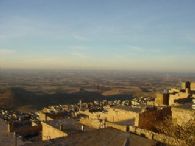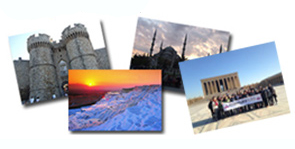Gap - Eastern Anatolian Tour
Duration: 10 days
Start-Finish: Bodrum - Bodrum
Accommodation:
Date:
Min-Max Group: 12-44
Tour price: Please contact us for rates

 Day1 Ankara --- Tour introduction. Dinner will follow the briefing.
Day1 Ankara --- Tour introduction. Dinner will follow the briefing.
Day2 - Kayseri --- After breakfast we will drive to Hattusas, the capital city of the Hittite Empire, and explore the ruins from the 2nd millenium BC. We will see the incredible 200 feet tunnel beneath the walls, take a close look at the monumental gates of the city, and walk around the great Temple of Storm God Teshup. Alacahoyuk and the Hittite temple 'Yazilikaya'· are also included in the tour. At dinner, we will taste the local delicacies of Kayseri.
Day3 - K.Maras --- We will tour the downtown area in the morning. Visit the Museum of Medical History, a 13th century Seljuk hospital for mental diseases. Uc Kumbetler are fine examples of Seljuk architecture. We will also see the colorful bazaar. Later in the day we will drive to Maras, a growing city of the east famous for its delicious ice cream. We will get more familiar with the ethnic diversity of Turkey as we visit a small village en route called Mehmet Bey. The locals will host our group for lunch, and lead us around their village. As we arrive in Maras, we'll take a stroll to see the coppersmith's bazaar.
Day4 - Adiyaman --- Roughly two thousand years ago, King Antiochos of Commagene to satisfy his ego had chosen the very top of Mount Nemrut as the site for his burial, far from the eyes like an eagle's nest. And his statue is still among the statues of his equals, the Gods. On our way to the summit of Mt. Nemrut, we'll visit the two other attractions, Karakus and Arsameia. Sunset at the summit of Mt. Nemrut. This historic monument is listed as a world heritage site by Unesco.
Day5 - S.Urfa --- They call it the city of prophets, Urfa is one of the prosperous cities in southeast Turkey with a proud history. On the way to Urfa, we will get to know more on the GAP (South Eastern Anatolia Project) and the largest water reservoir incorporated in this project. As we arrive in Urfa, we will see the 'Pool of the Sacred Carp'. Also, we will see the 'Dergah', and the cave that is believed to be the birthplace of prophet Abraham. The local bazaar will take us into the colorful world of cloths, spices, copperware, and many others. As we get together with the locals, they will tell us all about their interest in pigeons, and why they are willing to pay a small fortune for a pair.
Day6 - S.Urfa --- In the morning we will drive to Harran, on the Syrian border. The city has been proudly witnessing the progress of mankind since the beginning of written history. Harran is where Abraham and his family started on their journey to Canaan. Not only its biblical past, the ruins of the nearby temple, the ancient university complex and the unique beehive houses are also worth the attention. This afternoon will be free of group activity.
Day7 - Mardin --- In the morning we will be on the road to Mardin, along the infinite plains of Mesopotamia. As we arrive in the city we·ll visit 'Deyrul Zafaran', the Saffron Monastery, that was once the seat of the Syrian Orthodox Patriarch. The community still speak the old Arameic. We'll take a stroll to see the old town and observe the unique stone masonry.
Day8 - Mardin --- Depart for Savur, well known for its distinct architecture and vineyards. In the village of Killit we will have lunch in a 400 years old estate with the family that lives there. As we return to Mardin we will visit 'Aunt Nasra' who is a master in making and painting church curtains. She is the last remaining artist to carry out this traditional handicraft.
Day9 - Diyarbakir --- The fertile land known as the Upper Mesopotamia had been a major interest for many civilizations throughout the history. Today we'll visit Hasankayf on the Tigris, the city that once controlled trade routes along the river. The ruins of this once glorious town are breathtaking. We will continue on to Diyarbakir. As we walk on the narrow streets of old Diyarbakir, we'll observe a unique harmony of cultures, styles, and architecture. Here we will visit the impressive basalt walls that once protected the city and the Grand Mosque from the Seldjuk times that is truly remarkable with perfect stone masonry.
day10 - Van --- The city of Van was the capital of ancient Urartia, and has always been an important settlement of the East. Today the city is known for its cats. Quite curious, these beautiful white cats have different eye colors. On the way to Van, we will stop south of the Great Lake Van and take a boat to Akdamar Island to visit the Church of Holy Cross, or simply the Akdamar Church which is one of the masterpieces of Armenian architecture. You may swim in the lake, and maybe listen to the stories of the locals about the present time mythological monster of Lake Van. Later in the day we'll visit the Urartian Citadel in the outskirts of Van.
Day11 - Van --- Today we will discover the historic settlements in the vicinity. We'll drive to Cavustepe that was home to the mighty Urartian kings and learn more about the Urartian culture. Later in the day we will visit the Hosap Castle from 17th century which was built by a Kurdish landlord. History of the site and the region will help to better understand the current social structure and the cultural diversity of Eastern Turkey.
Day12 - Kars --- Mt. Ararat has always attracted travelers from all around the world, many came in search of the remains of Noahs Ark, others to take the challenge and climb the highest mountain in Turkey. The outstanding palace of Ishak Pasa was built towards the end of the 18th century. The palace and the town have a great location, on the major trade route of the past. The unique style can only be described as eclectic. Drive to Kars for overnight.
Day13 - Erzurum --- The city of Ani was one of the major settlements in the Middle Ages. Almost all major attractions in town are in perfect state of preservation. As we tour this impressive site, we will see the massive fortification walls, Church of St. Gregory, the Cathedral, Menucher Mosque, and the Seldjuk Caravanserai, as well as the bridge that connected the two banks of the river. City of Erzurum had been the stronghold of many invading armies as it linked the ancient trade routes. The reminders of its glorious past are still in situ. The Twin Minaret Medrese, Seldjuk tombs, and Rustem Pasa Bedestan are among the places we'll visit in Erzurum. The Bedestan today is a centre for the manufacture of 'Oltutasi', the black stone of Erzurum.
Day14 - Istanbul --- We will take the morning flight to Istanbul. The day will end with the farewell dinner.
Day15 --- Tour ends after breakfast.
The Southeastern Anatolia:
With its high mountain ranges, valleys, plains and lakes,streams and riverbeds integrated with colors of purple, brown, grey, yellow and red ,and adorned with the unique architectural samples of Turkish culture, East and Southeast Anatolian Region bring to the sight pleasurable panoramic views...
Nemrut Mountain, Adiyaman
The Southeastern Anatolia Region has a very rich history and cultural heritage, as can be seen in its magnificent historic sites. Its history begins around 7000 B.C. in the New Stone Age. Between 2,000 B.C. and 1,500 B.C. came the Hurris who were followed by the Hittites sometime around 1,200 B.C.
In the land which encircles the Firat (Euphrates) and the Dicle (Tigris) Rivers, lived Abraham, the patriarch claimed by three global religions. Some think that Abraham was born in what is now called Sanli Urfa, supposed to have been Ur of the Chaldees, and later moved south from the city to Harran. In Harran, which was an important Mesopotamian historic and cultural center, the ruins of one of the largest and oldest Islamic universities can be seen among the archeological remains. Restoration of the 18th-century mansion, Kucuk Haci Mustafa Hacikamiloglu Konagi, is now complete. It has reopened as an art gallery.
When you travel from the south to the north over the Mesopotamian plains, the first high mountain to be seen is the picturesque Mount Nemrut, with the mausoleum of the Commagene King Antiochus at its 2,150 m peak. The most important areas of the region are Diyarbakir; whose city walls are a superb example of medieval military architecture; Mardin, with its regional architecture; and Gaziantep, a large trade and industrial center which contains the remains of late Hittite cities.
The Ataturk Dam Lake is the region's holiday and water sports center. There are many beaches along the shore, which can give you an unforgettable holiday experience under the Mesopotamian sun.


